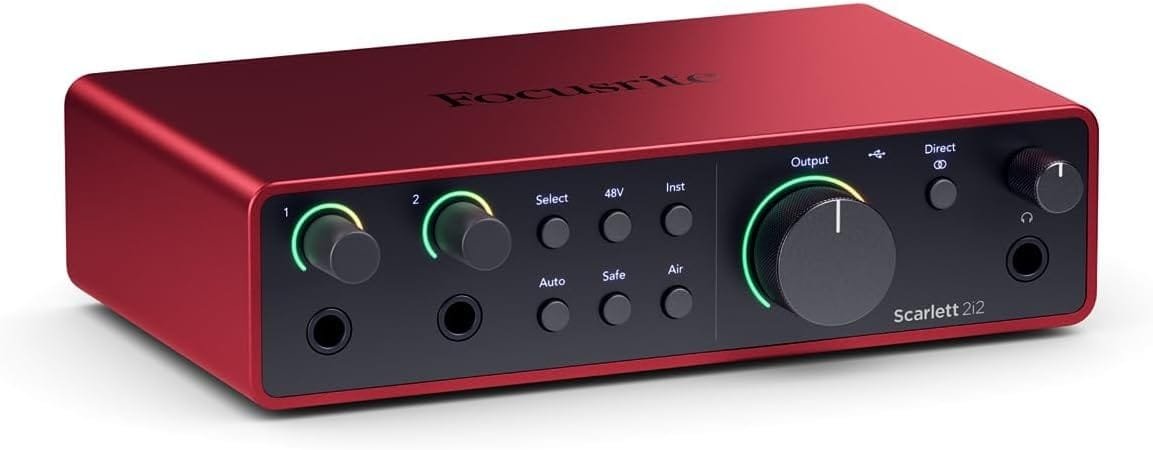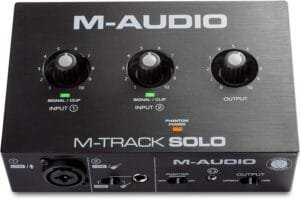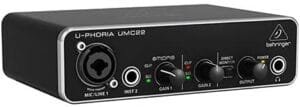Introduction to Audio Interfaces
An audio interface serves as a critical component in the realm of music production, particularly for guitarists. It functions as a bridge between musical instruments, such as electric guitars, and digital audio workstations (DAWs) or recording equipment. This technology allows for the conversion of analog signals produced by guitars into digital formats that can be easily processed, recorded, and manipulated on a computer. The significance of audio interfaces extends beyond mere connection; they play a fundamental role in capturing high-quality sound, which is essential for musicians committed to achieving professional results.
For guitarists, the choice of audio interface can dramatically influence the quality of recorded sound. A well-designed audio interface can facilitate a direct and clean signal flow, minimizing latency and ensuring that the nuances of a guitarist’s performance are retained in the recording process. This is particularly important during tasks such as layering guitar tracks, applying effects, or mixing. Furthermore, many modern audio interfaces come equipped with additional features like built-in preamps and instrument inputs, which can further enhance the recording experience.
Besides connectivity and sound quality, many audio interfaces offer user-friendly interfaces with intuitive controls, making them accessible for both novice and experienced musicians alike. Some models even support various formats and connections, such as MIDI and USB-C, making them versatile for different setups. In an age where sound quality and production value are immense factors in the music industry, investing in a good audio interface becomes paramount for guitarists looking to take their music to the next level. Understanding the crucial role these devices play will aid guitarists in making informed decisions when selecting the right fit for their sonic needs.
Key Features to Consider
When purchasing an audio interface, several key features should be taken into account to ensure that the device meets your specific needs as a guitarist. One of the most crucial specifications is the bit depth, which refers to the number of bits of information in each sample. A higher bit depth, such as 24-bit, allows for greater dynamic range and more detailed sound quality, which can be particularly beneficial when capturing the nuances of guitar performance. Coupled with bit depth, the sample rate is equally important; standard rates of 44.1 kHz or higher, such as 96 kHz, result in improved audio fidelity and clarity.
Another essential feature is the number of inputs and outputs available on the audio interface. Guitarists may need multiple inputs for connecting various instruments or microphones simultaneously, especially during recording sessions. Additionally, having enough outputs allows for monitoring through different speakers or headphones, facilitating a better mixing experience.
Latency is another critical factor that can significantly impact recording sessions. Latency refers to the delay between playing a note on the guitar and hearing it through the interface. A low-latency audio interface ensures that musicians experience minimal delay, which is vital for real-time performance and monitoring. It’s also worth considering the quality of the preamps within the interface, as high-quality preamps can enhance the overall sound captured from your guitar or other instruments.
Finally, compatibility with various digital audio workstations (DAWs) is essential. Ensure that the chosen audio interface supports the DAWs you intend to use, allowing for seamless integration into your recording setup. By evaluating these key features, guitarists can make an informed decision when selecting the right audio interface to suit their unique recording requirements.
High-End Audio Interface Models
When it comes to high-end audio interfaces for guitarists, several models stand out due to their exceptional sound quality, features, and reliability. These interfaces not only elevate your recording experience but also enhance the overall performance of your musical production endeavors.
One of the leading models is the Universal Audio Apollo X4, which is renowned for its outstanding audio fidelity and real-time UAD processing capabilities. It features four mic preamps, providing a wide range of connectivity options for your guitar and other instruments. The preamps deliver a warm, vintage tone, making them a favorite among professionals. However, with a price point around $1,799, it’s essential to weigh its significant benefits against your budget.
Another excellent choice is the Focusrite Clarett 4Pre, which combines high-quality AD/DA conversion with ultra-low latency performance. This interface is particularly advantageous for guitarists due to its Air mode, which enhances high frequencies, making guitar recordings shine. Priced at about $599, it offers great value for those seeking professional-grade sound without breaking the bank. Nevertheless, users should be mindful that its limited outputs can be a drawback for larger setups.
Lastly, the MOTU 8M is worth considering, especially for its flexibility and extensive feature set. With eight inputs, this interface caters to guitarists who might want to record multiple instruments simultaneously. Its built-in DSP effects and low-latency monitoring are significant assets, and its price of around $749 positions it competitively in the high-end market. While the MOTU 8M excels in performance, some users have noted a steeper learning curve related to its software interface.
In summary, high-end audio interfaces such as the Universal Audio Apollo X4, Focusrite Clarett 4Pre, and MOTU 8M offer guitarists a diverse range of features and sound quality. Understanding the pros and cons of each model will help you make an informed choice tailored to your specific recording needs and budget.
Low-End Audio Interface Models
For budget-conscious guitarists, exploring low-end audio interface models can yield impressive results without breaking the bank. Several options on the market offer reliable performance and essential features tailored to the needs of home recording. These affordable audio interfaces typically have one or two inputs, allowing guitarists to easily connect their instruments. Although they may lack some of the advanced functionalities found in more expensive models, many still provide satisfactory sound quality suitable for practice and recording.
A popular choice among entry-level guitarists is the Focusrite Scarlett Solo. This device is compact and portable, making it a great companion for traveling musicians. The Scarlett Solo boasts a high-quality microphone preamp and a dedicated guitar input, delivering clear audio reproduction. Likewise, the PreSonus AudioBox USB 96 is another budget-friendly option that comes with two combo inputs and MIDI capability, allowing musicians to connect various instruments and expand their recording options. Both models make it easy to monitor audio levels in real-time, which is vital for achieving optimal sound balance.
When comparing low-end interfaces to their higher-end counterparts, it is essential to note that while pricing reflects a difference in build quality and additional features, many entry-level options are more than sufficient for home recording. They typically offer limited latency and solid connectivity through USB, enabling seamless integration with digital audio workstations. Moreover, makers often provide bundled software, which means guitarists can start recording right away without the need for additional purchases.
Ultimately, when selecting a low-end audio interface, it is imperative for musicians to consider their specific needs, play styles, and recording goals. This ensures they invest in a model that not only fits their budget but also supports their artistic expression. With careful consideration, finding a reliable audio interface on a budget can dramatically enhance the home recording experience without compromising sound integrity.
Recommended Model for Home Use
After an extensive review of both high-end and low-end audio interfaces, the Focusrite Scarlett 2i2 (3rd Gen) is a standout choice for home use among guitarists. This interface combines quality, affordability, and ease of use, making it an excellent option for amateur and semi-professional musicians alike. With its sleek design, the Scarlett 2i2 enhances the home recording experience while providing the necessary features to produce high-quality sound.
Feature-rich, the Scarlett 2i2 offers two high-performance mic preamps equipped with a gain control that allows users to capture clean and vibrant audio. The 24-bit/192kHz converter ensures precise sound reproduction, making it well-suited for recording guitar with clarity and detail. The interface also features a direct monitoring option that enables players to hear their instrument in real-time, without any noticeable latency, an essential aspect for any guitarist during recording sessions.
User-friendliness is another significant aspect of the Focusrite Scarlett 2i2. Its plug-and-play functionality allows for easy integration with various digital audio workstations (DAWs), which is vital for those just starting their recording journey. Compatible with Mac and Windows systems, it provides flexibility for users regardless of their operating system preference.
Overall, the Focusrite Scarlett 2i2 excels in performance, delivering professional sound quality within a compact and affordable package. This model stands out for home recording due to its intuitive features and compatibility, catering specifically to the needs of guitarists who wish to record at home. Whether producing tracks, engaging in practice sessions, or collaborating with fellow musicians, this audio interface serves as a reliable tool that enhances the home studio experience.
Setting Up Your Audio Interface
Setting up your audio interface for guitar recording at home can initially seem daunting, but with a straightforward approach, it can be done efficiently. Begin by selecting the appropriate audio interface, ensuring that it is compatible with your computer’s operating system. Once you have your gear in hand, the first step is to connect your audio interface to your computer using a USB or Thunderbolt cable, depending on the model. For best results, plug the interface into a direct USB port rather than using a hub, which may cause latency issues.
Next, it is essential to install the necessary drivers for your audio interface. Most manufacturers provide these on their website or in the packaging that comes with the device. Download and install the correct drivers to ensure your computer recognizes the interface and functions efficiently. Upon completion, restart your computer to finalize the installation and sync the audio interface with your system.
After the drivers are installed, open your Digital Audio Workstation (DAW) of choice. In the DAW, navigate to the audio settings or preferences. Here, you will need to select your audio interface as the primary input and output device. Additionally, adjust the buffer size to a suitable setting, which is generally lower for recording and higher for mixing to reduce latency during playback.
Now, it’s time to connect your guitar. Plug your instrument cable into the input of the audio interface. Some interfaces may have a dedicated instrument input, while others may use standard line inputs with preamps. Once plugged in, ensure that the gain levels are appropriately set; a good rule of thumb is to keep the level at around 75% to avoid clipping. Finally, ensure your DAW is set to record from the correct input channel when you’re ready to create music. With these steps, you are now prepared to start your recording journey!
Tips for Getting the Best Sound
To achieve the best sound quality when using an audio interface, it is crucial to understand the importance of proper gain staging. Gain staging refers to the management of audio signal levels throughout the recording chain. It is essential to set the gain on your audio interface correctly, ensuring that your guitar signal is strong enough to be picked up without distortion, while also avoiding clipping. Aiming to keep the levels in the green range on your audio interface will help maintain clarity and fidelity, resulting in a more professional sound. Additionally, regularly monitoring levels while recording can prevent less-than-ideal results.
For those utilizing microphones for acoustic guitar or vocals, mic placement is a key factor that can significantly influence the overall sound. Experimenting with distance and angle can yield different tonal characteristics. For instance, placing the microphone too close may yield excessive bass and a ‘boomy’ sound, while positioning it farther away could result in a thin, less defined tone. It is often beneficial to perform test recordings to determine the ideal placement before finalizing the setup. Always consider the environment in which you are recording; reflective surfaces can add unwanted reverb, affecting the clarity of the recording.
Furthermore, using effects responsibly can enhance your audio without compromising quality. While effects like reverb, delay, or compression can add depth and dimension to your sound, overapplying them can muddy the final mix. It is recommended to record with a clean tone and apply effects during the mixing process. This approach allows for more flexibility and precision in applying effects, ensuring that they contribute rather than detract from the overall sound. By focusing on these aspects, guitarists can maximize the potential of their audio interface and achieve high-quality recordings that showcase their musical talent.
Common Issues and Troubleshooting
When using audio interfaces, guitarists may encounter a range of issues that can disrupt their recording and performance processes. One frequent problem is latency, which refers to the delay between playing an instrument and hearing the sound through the audio interface. This delay can hinder a guitarist’s performance, making it challenging to play in time. To minimize latency, it is recommended to adjust buffer settings in the audio interface’s software. Lowering the buffer size will usually alleviate the issue; however, this may require a more powerful computer. Additionally, ensuring that your audio drivers are updated can significantly enhance performance.
Another common issue that guitarists might face is driver conflicts, which occur when multiple devices attempt to use the same driver, leading to malfunctioning audio output. It is important to verify that the correct drivers are installed and to remove any unused audio drivers to prevent conflicts. Checking the device manager on the computer and ensuring the audio interface driver is functioning properly can help in resolving these conflicts effectively.
Connection problems may also arise, primarily if the interface is either not properly connected to the computer or suffering from a faulty cable. Ensuring that USB or other connection cables are securely plugged in is the first step in troubleshooting. Using different cables or ports can help identify if a cable issue is the source of the problem. If the interface is not recognized by the computer, restarting both the audio interface and the computer can often resolve temporary hiccups.
By addressing these common issues—latency, driver conflicts, and connection problems—guitarists can enhance their experience with audio interfaces, ensuring a smoother recording process. With the right precautions and knowledge about troubleshooting, technical difficulties need not hinder creativity or productivity.
Conclusion and Thank You
As we have explored throughout this guide, selecting the appropriate audio interface is a crucial decision for guitarists aiming to enhance their sound quality and recording capabilities. The right audio interface not only facilitates superior sound processing but also ensures compatibility with your preferred digital audio workstation (DAW). Whether you are a beginner or a seasoned musician, understanding the features, connectivity options, and performance specifications of various audio interfaces can have a significant impact on your music production experience.
We have discussed key factors such as audio quality, latency, input and output options, and the importance of preamps. These aspects are essential for any guitarist looking to achieve a professional sound. Moreover, we have highlighted the diverse range of models available, ranging from budget-friendly options to high-end solutions tailored for advanced users. Each interface has its unique advantages and drawbacks, and the ideal choice will depend on your specific needs and workflow.
We sincerely appreciate your engagement with this blog post and encourage you to share your own experiences with audio interfaces in the comments section below. Your insights could be invaluable to other guitarists navigating similar decisions. Additionally, if you have any questions or require further clarification on any points discussed, please feel free to reach out. We are here to assist you on your musical journey and help you find the right fit for your unique style and requirements.
Thank you once again for your continued support, and we hope this guide has served as a helpful resource in your quest for the perfect audio interface.



























